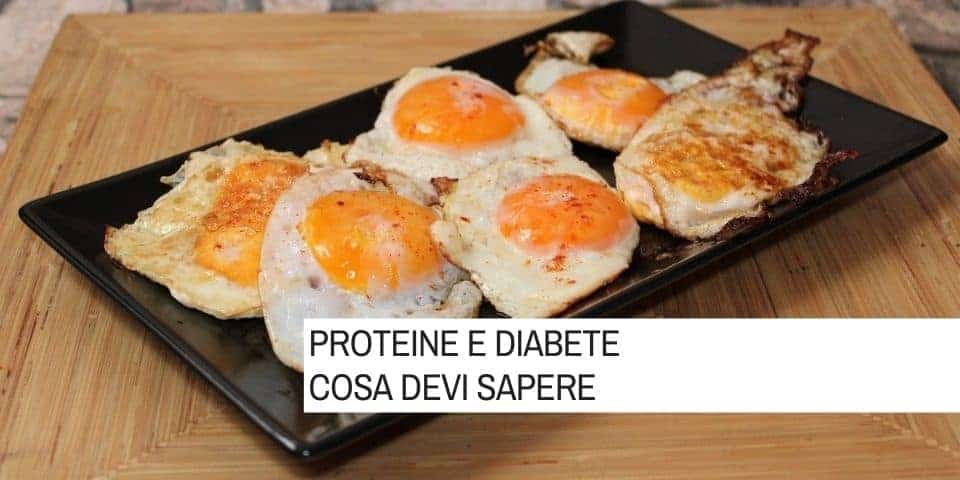Proteine e diabete: cosa devi sapere
Le proteine sono uno dei tre macronutrienti essenziali in una dieta alimentare, insieme a carboidrati e grassi. Solitamente, le persone con diabete tendono a concentrare l’attenzione sui carboidrati e sui grassi, pensando che l’aumento della glicemia nel sangue dipenda unicamente da questi ultimi. In realtà, le proteine rivestono grande importanza nell’alimentazione, in quanto entrano nella costituzione delle principali strutture dei tessuti. Oltre a essere necessarie per creare e riparare i muscoli, le proteine sono fondamentali componenti di organi e pelle, ma sono anche enzimi, ormoni, anticorpi del sistema immunitario, neurotrasmettitori e varie piccole molecole che svolgono molte importanti funzioni.
Cosa sono e quali funzioni hanno le proteine?

Come anticipato nell’introduzione, il nostro organismo utilizza le proteine per costruire, riparare e mantenere la maggior parte dei tessuti e degli organi del corpo. Le proteine, però sono anche necessarie per la funzione del sistema immunitario e per alcuni processi fisiologici aggiuntivi.
Esse sono composte da catene di unità costitutive, note con il termine di aminoacidi. Vi sono 20 tipi diversi di aminoacidi, comunemente presenti nelle piante e negli animali e, inoltre, le proteine vengono distinte in due gruppi:
- gli aminoacidi essenziali non possono essere prodotti dall’organismo e quindi devono provenire, necessariamente, dalla nostra alimentazione;
- gli aminoacidi non essenziali possono essere prodotti dall’organismo e quindi non devono essere assunti attraverso l’alimentazione.
Quali alimenti sono ricchi di proteine?

Le proteine possono essere trovate in alimenti sia di origine vegetale che animale. Le fonti alimentari ricche di proteine forniscono una varietà di nutrienti per mantenere il corpo in buona salute. Ci sono molte fonti di proteine alimentari, tra cui:
- Pollame (pollo o tacchino)
- Pesce e frutti di mare
- Uova
- Latticini (latte, formaggio, yogurt)
- Carni rosse (manzo, maiale, agnello, ecc.)
- Proteine vegetali come noci, semi, soia e fagioli.
Quale alimentazione può essere più indicata per una persona con il diabete?
Qualunque sia il tipo di diabete (tipo 1 o tipo 2) ed il trattamento terapeutico scelto, la persona con diabete deve assumere alimenti consigliati per mantenere un buono stato di salute. La dieta deve essere equilibrata in termini di macronutrienti (carboidrati, proteine, grassi) ed impostata per la maggior parte dei casi su uno schema a cinque pasti giornalieri.
In caso di terapia insulinica intensiva, potrebbe essere più indicato adottare uno schema dietetico suddiviso in tre pasti principali prima dei quali viene suggerita la terapia insulinica. La dieta della persona che ha il diabete deve contenere, oltre ai carboidrati, anche altri nutrienti essenziali: le proteine e i grassi, naturalmente non bisogna assumerne in eccesso.
Quante proteine devono assumere le persone con il diabete?
Il fabbisogno proteico è calcolato in base alla necessità fisiche e fisiologiche. Esso è più alto in fase di crescita, quindi nei bambini e adolescenti (1-17 anni), si può ridurre o aumentare in base allo stile di vita nell’età adulta e si deve un po’ aumentare nell’anziano, per contrastare la perdita di massa muscolare, sempre che non ci sia la riduzione della funzionalità di alcuni organi, come i reni.

In relazione al diabete, l’assunzione di proteine non sembrerebbe avere alcun impatto sul modo in cui lo zucchero viene assorbito e non avrebbe effetti a lungo termine sul fabbisogno di zucchero nel sangue o di insulina.
Ciò significa che, se una persona con diabete passa a una dieta ricca di proteine, qualsiasi beneficio terapeutico è probabilmente dovuto alla contemporanea riduzione di carboidrati, non alla proteina stessa. Questa è un’assunzione importante per una dieta a base di carboidrati coerente, che può aiutare a controllare il diabete di tipo 2.
Nel caso in cui, invece, la persona soffre di nefropatia diabetica, che è una patologia renale correlata al diabete, il consumo di proteine deve essere limitato. In questo caso infatti, l’apporto proteico consigliato è di circa un grammo, o meno, per chilogrammo di peso corporeo. Sarà quindi necessario consultare il proprio medico per determinare la quantità di proteine di cui si ha bisogno ogni giorno. Se da un lato, troppe proteine potrebbero essere dannose per i reni, dall’altro, troppo poche potrebbero portare alla malnutrizione ed alla perdita di peso involontaria.
I pasti ricchi di proteine richiedono insulina extra?
Le persone con diabete di tipo 1 hanno bisogno di quasi il 50% di insulina in più per mantenere stabili i livelli di glucosio dopo un pasto ricco di proteine. La maggior parte di insulina extra è necessaria nelle due ore successive al pasto.
Le persone che assumono insulina durante i pasti, devono prendere in considerazione l’effetto della proteina (o del grasso). Per i pasti abbondanti, alcune persone aumentano la dose assumendo meno insulina durante il pasto e poi un bolo di correzione in seguito, oppure, usano la pompa di insulina per erogare un bolo doppio o prolungato, dove il bolo sta per una dose aggiuntiva che consenta di correggere un’iperglicemia inattesa.
In questo modo, i grandi “pasti misti” possono rappresentare un problema, perché prendere troppa insulina troppo presto potrebbe causare una diminuzione. Un’ottima idea sarebbe quella di testare la glicemia poche ore dopo il pasto o, se è disponibile, utilizzare un monitor continuo del glucosio (CGM).
In conclusione, non si può pensare di gestire una patologia come il diabete solo con i farmaci prescindendo dallo stile di vita che si adotta. L’alimentazione e lo stile di vita sono fondamentali, ma entrambi devono essere accompagnati da un costante ausilio del medico, del diabetologo e di un nutrizionista, le uniche figure che sapranno indicare le migliori scelte nutrizionali che possano calibrarsi con le indicazioni del piano terapeutico adottato per ciascuna persona.
Fonti di questo articolo
Articoli correlati
Panoramica sulla Privacy
| Cookie | Durata | Descrizione |
|---|---|---|
| _abck | 1 year | This cookie is used to detect and defend when a client attempt to replay a cookie.This cookie manages the interaction with online bots and takes the appropriate actions. |
| ak_bmsc | 2 hours | This cookie is used by Akamai to optimize site security by distinguishing between humans and bots |
| bm_sz | 4 hours | This cookie is set by the provider Akamai Bot Manager. This cookie is used to manage the interaction with the online bots. It also helps in fraud preventions |
| cookielawinfo-checkbox-necessari | 1 year | The cookie is set by the GDPR Cookie Consent plugin to record the user consent for the cookies in the category "Necessary". |
| CookieLawInfoConsent | 1 year | Records the default button state of the corresponding category & the status of CCPA. It works only in coordination with the primary cookie. |
| viewed_cookie_policy | 1 year | The cookie is set by the GDPR Cookie Consent plugin to store whether or not the user has consented to the use of cookies. It does not store any personal data. |
| Cookie | Durata | Descrizione |
|---|---|---|
| _mcid | 1 year | This is a Mailchimp functionality cookie used to evaluate the UI/UX interaction with its platform |
| Cookie | Durata | Descrizione |
|---|---|---|
| _ga | 2 years | The _ga cookie, installed by Google Analytics, calculates visitor, session and campaign data and also keeps track of site usage for the site's analytics report. The cookie stores information anonymously and assigns a randomly generated number to recognize unique visitors. |
| _ga_68YV86XRT8 | 2 years | This cookie is installed by Google Analytics. |
| _gcl_au | 3 months | Provided by Google Tag Manager to experiment advertisement efficiency of websites using their services. |
| CONSENT | 2 years | YouTube sets this cookie via embedded youtube-videos and registers anonymous statistical data. |
| Cookie | Durata | Descrizione |
|---|---|---|
| _fbp | session | This cookie is set by Facebook to display advertisements when either on Facebook or on a digital platform powered by Facebook advertising, after visiting the website. |
| fr | 3 months | Facebook sets this cookie to show relevant advertisements to users by tracking user behaviour across the web, on sites that have Facebook pixel or Facebook social plugin. |
| IDE | 1 year 24 days | Google DoubleClick IDE cookies are used to store information about how the user uses the website to present them with relevant ads and according to the user profile. |
| test_cookie | 15 minutes | The test_cookie is set by doubleclick.net and is used to determine if the user's browser supports cookies. |
| VISITOR_INFO1_LIVE | 5 months 27 days | A cookie set by YouTube to measure bandwidth that determines whether the user gets the new or old player interface. |
| YSC | session | YSC cookie is set by Youtube and is used to track the views of embedded videos on Youtube pages. |
| yt-remote-connected-devices | never | YouTube sets this cookie to store the video preferences of the user using embedded YouTube video. |
| yt-remote-device-id | never | YouTube sets this cookie to store the video preferences of the user using embedded YouTube video. |
| Cookie | Durata | Descrizione |
|---|---|---|
| cookielawinfo-checkbox-altri | 1 year | No description |
| cookielawinfo-checkbox-analisi | 1 year | No description |
| cookielawinfo-checkbox-funzionali | 1 year | No description |
| cookielawinfo-checkbox-prestazioni | 1 year | No description |
| cookielawinfo-checkbox-pubblicita | 1 year | No description |
| mc_landing_site | 7 days | No description available. |
| Cookie | Durata | Descrizione |
|---|---|---|
| _abck | 1 year | This cookie is used to detect and defend when a client attempt to replay a cookie.This cookie manages the interaction with online bots and takes the appropriate actions. |
| ak_bmsc | 2 hours | This cookie is used by Akamai to optimize site security by distinguishing between humans and bots |
| bm_sz | 4 hours | This cookie is set by the provider Akamai Bot Manager. This cookie is used to manage the interaction with the online bots. It also helps in fraud preventions |
| cookielawinfo-checkbox-necessari | 1 year | The cookie is set by the GDPR Cookie Consent plugin to record the user consent for the cookies in the category "Necessary". |
| CookieLawInfoConsent | 1 year | Records the default button state of the corresponding category & the status of CCPA. It works only in coordination with the primary cookie. |
| viewed_cookie_policy | 1 year | The cookie is set by the GDPR Cookie Consent plugin to store whether or not the user has consented to the use of cookies. It does not store any personal data. |
| Cookie | Durata | Descrizione |
|---|---|---|
| cookielawinfo-checkbox-altri | 1 year | No description |
| cookielawinfo-checkbox-analisi | 1 year | No description |
| cookielawinfo-checkbox-funzionali | 1 year | No description |
| cookielawinfo-checkbox-prestazioni | 1 year | No description |
| cookielawinfo-checkbox-pubblicita | 1 year | No description |
| mc_landing_site | 7 days | No description available. |
| Cookie | Durata | Descrizione |
|---|---|---|
| _fbp | session | This cookie is set by Facebook to display advertisements when either on Facebook or on a digital platform powered by Facebook advertising, after visiting the website. |
| fr | 3 months | Facebook sets this cookie to show relevant advertisements to users by tracking user behaviour across the web, on sites that have Facebook pixel or Facebook social plugin. |
| IDE | 1 year 24 days | Google DoubleClick IDE cookies are used to store information about how the user uses the website to present them with relevant ads and according to the user profile. |
| test_cookie | 15 minutes | The test_cookie is set by doubleclick.net and is used to determine if the user's browser supports cookies. |
| VISITOR_INFO1_LIVE | 5 months 27 days | A cookie set by YouTube to measure bandwidth that determines whether the user gets the new or old player interface. |
| YSC | session | YSC cookie is set by Youtube and is used to track the views of embedded videos on Youtube pages. |
| yt-remote-connected-devices | never | YouTube sets this cookie to store the video preferences of the user using embedded YouTube video. |
| yt-remote-device-id | never | YouTube sets this cookie to store the video preferences of the user using embedded YouTube video. |
| Cookie | Durata | Descrizione |
|---|---|---|
| _ga | 2 years | The _ga cookie, installed by Google Analytics, calculates visitor, session and campaign data and also keeps track of site usage for the site's analytics report. The cookie stores information anonymously and assigns a randomly generated number to recognize unique visitors. |
| _ga_68YV86XRT8 | 2 years | This cookie is installed by Google Analytics. |
| _gcl_au | 3 months | Provided by Google Tag Manager to experiment advertisement efficiency of websites using their services. |
| CONSENT | 2 years | YouTube sets this cookie via embedded youtube-videos and registers anonymous statistical data. |
| Cookie | Durata | Descrizione |
|---|---|---|
| _mcid | 1 year | This is a Mailchimp functionality cookie used to evaluate the UI/UX interaction with its platform |





